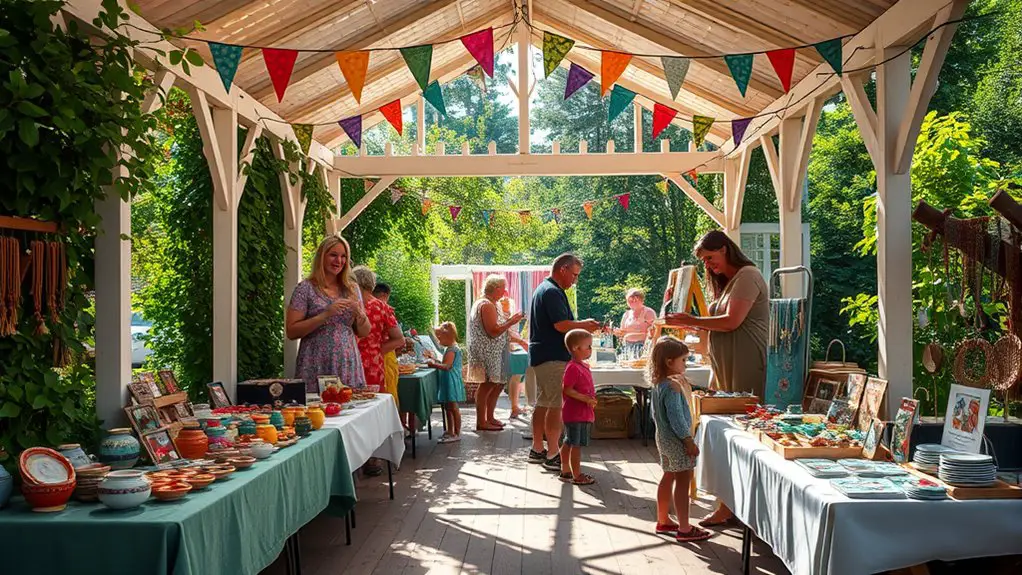To organize a craft fair in your gazebo, start by choosing a suitable date and time that avoids local events. Select diverse, high-quality vendors to enhance the atmosphere. Plan a U-shape layout for easy navigation, and create an inviting vibe with decorations and comfortable seating. Use social media and local flyers for promotion. Finally, evaluate the event through surveys and informal chats to gather feedback. There’s much more to explore about making your fair a success!
Choosing the Right Date and Time
When should you host your craft fair to attract the most visitors? Timing’s everything, so consider local events and weather considerations. Spring and early fall often provide mild weather, encouraging foot traffic. Avoid clashes with major local events, like festivals or farmer’s markets, which could divert attention from your fair.
You want your craft fair to be a destination, not a detour. Take a close look at community calendars; weekends usually draw larger crowds. A Saturday afternoon might be ideal, allowing visitors to leisurely explore. If you’re in a tourist area, aim for dates that align with peak travel seasons.
Remember to factor in weather; no one wants to browse crafts in the pouring rain. If your space has a gazebo, consider a date when you can easily accommodate both sun and showers. By thoughtfully choosing your date, you’ll create an inviting environment that embodies freedom and creativity.
Selecting Vendors and Craft Participants
As you plunge into the process of selecting vendors and craft participants, keep in mind that the quality and variety of offerings can make or break your craft fair. Your vendor selection should align with your vision, ensuring a mix that appeals to your audience. Establish participant criteria focused on craftsmanship, creativity, and originality.
Here’s a quick reference table to guide your selection process:
| Criteria | Importance |
|---|---|
| Craftsmanship Quality | High |
| Unique Offerings | High |
| Local Artisans | Medium |
| Price Range | Medium |
| Reliability of Vendors | High |
Incorporating diverse vendors can enhance the atmosphere and draw in more attendees. So, take your time to sift through applications, ensuring each participant contributes uniquely to your craft fair’s charm.
Planning the Layout of Your Gazebo
Planning the layout of your gazebo can greatly impact the flow and experience of your craft fair. Start by considering your gazebo dimensions; measuring the space lets you maximize vendor placements while guaranteeing easy access for attendees. Position tables in a U-shape or circular pattern, allowing for an inviting atmosphere where visitors can stroll freely.
Next, think about traffic flow. Create clear pathways that guide guests through the fair, preventing bottlenecks. Place your most popular vendors near the entrance to draw people in, while less crowded tables can be positioned further back.
Don’t forget to leave space for seating or relaxation areas, encouraging guests to linger. A well-planned layout not only enhances the aesthetic appeal but also fosters a sense of community. By organizing the space thoughtfully, you’ll guarantee everyone enjoys an unforgettable experience at your craft fair.
Creating an Inviting Atmosphere
An inviting atmosphere can transform your craft fair from a simple event into a memorable experience. Start by choosing inviting decorations that reflect the spirit of creativity and craftsmanship. Think colorful banners, handmade garlands, or even potted plants that add a touch of nature. Use soft lighting, like string lights or lanterns, to create warmth and charm as the day progresses.
Comfortable seating is essential, allowing visitors to rest and soak in the atmosphere. Consider placing cozy benches or eclectic chairs throughout your gazebo for a welcoming vibe. Arrange seating areas to encourage conversations among attendees, sparking connections and inspiration.
Don’t forget to incorporate engaging elements, such as live music or interactive craft stations, to elevate the experience. When your gazebo feels warm and inviting, attendees will linger longer, making your craft fair not just an event, but a delightful escape.
Marketing Your Craft Fair
To successfully draw attendees to your craft fair, it’s essential to implement a strategic marketing plan that captures attention and builds excitement. Start by leveraging social media platforms to spread the word. Create event pages and share engaging posts highlighting unique crafts, vendors, and activities.
Here’s a simple plan to organize your marketing efforts:
| Marketing Strategy | Details |
|---|---|
| Social Media Campaign | Use platforms like Facebook, Instagram, and Twitter to promote your event. |
| Flyers & Posters | Design eye-catching promotional materials to distribute locally. |
| Community Engagement | Partner with local businesses for cross-promotion. |
| Email Newsletters | Send invites to your mailing list to keep your audience informed. |
Setting Up Logistics and Equipment
When it comes to setting up your craft fair, planning the venue layout is essential for ensuring a smooth flow of foot traffic. You’ll need a detailed checklist of necessary equipment, from tables and chairs to signage and display materials. Don’t forget to address power and lighting setup to create an inviting atmosphere that showcases your vendors’ creations beautifully.
Venue Layout Planning
While planning the layout for your craft fair, it’s crucial to think about how the space will flow and accommodate both vendors and attendees. You want to optimize the space while ensuring a welcoming atmosphere. Consider these points for effective flow design:
- Vendor Placement: Arrange booths strategically to create a natural flow, ensuring popular vendors are easily accessible.
- Walkways: Design wide pathways between booths, allowing attendees to navigate comfortably and preventing congestion.
- Gathering Areas: Incorporate cozy spots with seating, where visitors can relax and enjoy their purchases, enhancing their experience.
Necessary Equipment Checklist
Organizing a craft fair requires a well-thought-out equipment checklist to guarantee everything runs smoothly on the day of the event. Start by gathering all essential craft supplies—tables, chairs, and display racks for vendors. Don’t forget signage to guide guests and promote your artists. You’ll also need bags or boxes for customers to carry their purchases.
Next, consider vendor necessities: power strips, extension cords, and tools for any last-minute adjustments. Bring along a first-aid kit, hand sanitizer, and a cooler for refreshments to keep everyone comfortable. Finally, make sure you have a reliable system for handling payments, whether it’s cash, cards, or mobile payments. This thorough checklist will help create an enjoyable experience for all involved.
Power and Lighting Setup
After guaranteeing you have all the necessary equipment, it’s time to focus on power and lighting setup, which plays a vital role in creating an inviting atmosphere for your craft fair. You’ll want to take into account your power sources and lighting options carefully. Here are three essential elements to include:
- Power Sources: Use generators or power strips to guarantee all vendors can access electricity without hiccups.
- Lighting Options: Examine string lights, lanterns, or LED spotlights to illuminate the gazebo and surrounding area effectively.
- Placement: Arrange power outlets and lights to minimize cords on the ground, reducing tripping hazards while enhancing the fair’s charm.
With the right setup, your craft fair will shine, inviting attendees to explore every creative corner.
Engaging the Community With Activities
To truly engage the community during your craft fair, incorporating interactive activities can transform a simple event into a vibrant celebration. Think about hosting interactive workshops that invite attendees to create alongside artisans. This not only fosters community engagement but also allows participants to explore their creativity.
Consider these activity ideas:
| Activity | Description |
|---|---|
| DIY Crafts | Provide materials for quick, fun projects. |
| Live Demonstrations | Showcase techniques by local artists. |
| Kids’ Corner | Set up a space for children to craft. |
| Community Art Wall | Have a large canvas where everyone can contribute. |
Evaluating the Event and Gathering Feedback
After the craft fair wraps up, it’s essential to gather insights on what worked and what didn’t. You can create post-event surveys to collect structured feedback from attendees and vendors, while informal conversations can reveal more nuanced impressions. This feedback will help you refine future events and guarantee they’re even more successful.
Post-Event Surveys
While organizing a craft fair can be an exhilarating experience, it’s essential to evaluate its success and gather valuable feedback through post-event surveys. These surveys allow you to collect post-event feedback from participants, ensuring you understand what worked and what didn’t.
Consider the following ways to structure your survey:
- Event Logistics: Ask for participant suggestions on venue, timing, and setup.
- Experience Quality: Gather insights on attendee interaction and overall enjoyment.
- Future Improvements: Encourage suggestions for enhancing future craft fairs.
Informal Conversations
Although formal surveys provide structured feedback, engaging in informal conversations can reveal insights that numbers often overlook. These casual chats foster community engagement and create stronger vendor networking opportunities. As you talk with attendees and vendors, listen for their experiences and suggestions. This valuable feedback can shape future events.
Here’s a quick overview of key conversation points:
| Topic | Feedback |
|---|---|
| Experience at the Fair | What did they enjoy most? |
| Vendor Connections | Did they meet new partners? |
| Improvements Suggested | What can be done better? |
Frequently Asked Questions
What Permits Do I Need for Hosting a Craft Fair?
When hosting a craft fair, you’ll need to check local regulations and understand vendor requirements. It’s vital to obtain necessary permits to guarantee a smooth, enjoyable experience for everyone involved. Don’t overlook these essentials!
How Can I Ensure the Safety of Vendors and Attendees?
To guarantee safety for everyone, establish clear vendor guidelines and enforce safety protocols. Make certain all vendors know emergency procedures, provide first aid kits, and maintain an open communication line for immediate assistance during the event.
What Insurance Coverage Should I Consider for the Event?
You wouldn’t want a rogue bee sting to turn your event into a circus! So, consider liability insurance and extensive event coverage. They’ll protect you from unexpected mishaps, ensuring freedom for everyone to enjoy the day.
How Do I Handle Unexpected Weather Conditions During the Fair?
To handle unexpected weather conditions, create a weather contingency plan. Guarantee vendors’ preparedness by providing guidelines on securing their setups and having tents ready for cover, letting everyone enjoy the fair, rain or shine!
Can I Charge an Admission Fee for Attendees?
You can charge admission fees for attendees, but consider ticket pricing carefully. Make certain it’s affordable and reflects the value of the experience. This way, you maintain a welcoming atmosphere while supporting your event’s costs.

